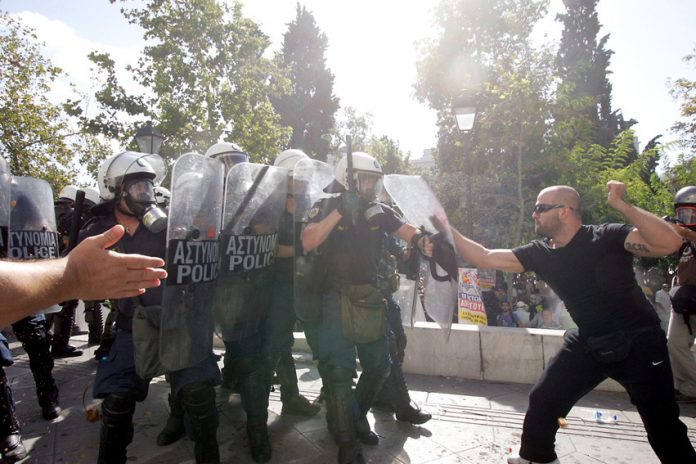
CHANTING ‘It’s their crisis – the solution is uprising!’; ‘Down with the government and the troika of the EC-IMF-ECB. The time has come for their overthrow!’; and ‘Permanent strike!’ over 120,000 workers, youth and students, professionals and shop-keepers demonstrated in Athens last Thursday afternoon as part of a one-day general strike called by the GSEE (Greek TUC) along with ADEDY (public sector trades unions federations).
The GSEE stated that there was a 100 per cent participation in the strike in ship-building, transport, refineries and ports, and 80 per cent in engineering, construction, hotels, banks and the public sector corporations.
Both the Athens march and the strike proved to be bigger than the previous one-day general strike of 26 September against the troika-imposed savage austerity measures which have led to a massive official 25 per cent unemployment rate, while 55 per cent of 15-24 years olds are out of work.
Militant mass marches and rallies were staged in all Greek cities and towns.
In Athens, as throughout Greece, lawyers, doctors, pharmacists, notaries, shop-keepers, family business and many other middle class sections, with their anti-government and anti-troika banners, joined the workers’ marches along with tens of thousands of students.
All banks, department stores and shops, except for some cafes, remained shut in the Athens city centre as well as in many areas of the capital. The pharmacists’, notaries’, doctors, courts staff and the Athens Bar had declared a 48-hour strike. Taxi drivers also joined the strike to 5.00pm.
During the day all museums and archaeological sites remained shut and in the evening all theatres, including the National Theatre and the Opera, remained dark. Archaeologists, actors, museum keepers and delegations from all Ministries demonstrated in Athens with their banners.
Although in Athens there were three distinct rallies organised, one by the Greek Communist Party (KKE), one by the Co-ordination of Trades Unions and one by the GSEE-ADEDY, the three separate marches merged into a huge one as they converge towards Syntagma Square where the Vouli (Greek parliament) is situated.
The biggest contingents to the march were local government workers, civil servants, health workers, secondary education teachers, hotel workers, building, port and engineering workers.
A group of emergency ambulance workers who carried a banner at the Athens march reading: ‘State and free health service is for us un-negotiable – enough is enough,’ spoke to News Line of their continuous fight, with strikes, demonstrations and occupations, against the government.
One of them, Dimitris Voulis, said: ‘We need an indefinite political general strike for the overthrow of the government and of the system which causes the crisis and brings poverty to workers.’
As the tens of thousands entered Syntagma Square marching to the Vouli, hundreds of riot police, all fully armed and ready, masks on, took battle positions outside the luxury hotels opposite the Vouli building.
Given a command, they suddenly blocked the road leading to the Vouli passing underneath the hotels. Workers shouted against them and immediately the riot police staged a tear-gas and smoke and noise bombs attack against the demonstrators.
But the size of the march and workers’ determination was more than enough to resist the riot police attack who did not dare to charge. The march continued its route this time around the square to the Vouli.
As the large square was being filled, the riot police made another attempt with scores of tear-gas canisters to stop and break the march into two and prevent it entering the square. Demonstrators reacted with stones, fruit, fireworks and some petrol bombs. Again, the riot police did not charge.
When the final contingents of the huge march entered the square, the riot police decided that was the time to attack with their truncheons and push demonstrators out of the lower part of the square.
Havoc followed as tear gas engulfed the crowds and people ran to safety. Still, tens of thousands remained in the square’s side streets. But, as in previous demonstrations, no leadership was available to organise them. The GSEE, the KKE and the SYRIZA (Coalition of the Radical left) leaders all had gone away.
Police announced some 110 arrests and many demonstrators needed hospital treatment. Then it became known that one of the marchers, 65-years-old unemployed seafarer Xenofon Loufaris, had died at the end of the march of a heart attack. He was the second worker in a year to have died following a demonstration.
Last Thursday’s strike and colossal demonstrations, unprecedented in the Greek provincial cities and towns, signify that the working class is in a state of uprising, demanding permanent strike action and the overthrow of the government and the troika. In this situation, with many banners carried last Thursday bearing ‘Uprising’ in large letters, several sections of workers are also demanding the overthrow of the system.
This is taking place along the big strikes and demonstrations in Portugal, Spain, Italy and France in recent weeks, and the deepening of the world economic crisis which is spreading panic and divisions, especially between the IMF and the German leadership of the European Union and of the Eurozone.
The GSEE President Yiannis Panagopoulos stated that the Portuguese, Spanish and Greek trades unions at a meeting in Madrid last week decided to hold a joint ‘day of mobilisations’ on 14 November.